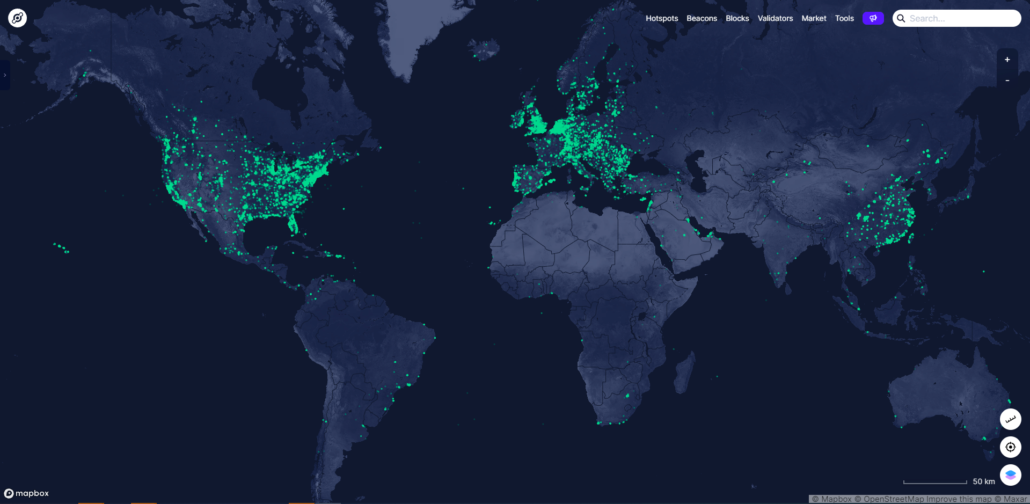This is a guest post by sp#8635 in our discord community. SP starts from knowing a little to successfully understand the process and improve his earning by a lot. This article is full of valuable experiences concluded by SP and thanks to him for sharing them with us. Welcome to anybody who is willing to share their thoughts or experience on SenseCAP M1 and HNT.
-
Basic Information
Contrary to popular belief, getting into Helium HNT is not just about getting a hotspot next to a window and becoming rich. There is quite some work that needs to be investigated to have the most profitable setup.
There are a couple of concepts to understand how you are rewarded for your setup before considering getting a hotspot.
Every 240 blocks (+/- 4 hours), your hotspot issues a challenge to the network. This challenge is usually sent to a random hotspot in the world and broadcasted by the said hotspot (beacon).
Statistically, you will also be challenged every 4 hours and will send a beacon. This beacon will be witnessed by nearby hotspots, effectively proving to the network that you exist, you are where you say you are and are providing LoRa coverage.
Finally, nearby hotspots will issue similar beacons, which your hotspot will witness and confirm the PoC or Proof of Coverage. The helium network is designed for low-power LoRa sensors, and as such, you will also see from time to time that you are transferring data from/to these sensors. However, the payments are not representative yet, unless you live in an area with thousands of active sensors, then it’s highly profitable.
The Helium network is about providing coverage with the right level of redundancy, which means that while it’s incentivized to go into new locations, it starts penalizing your rewards if too many hotspots are nearby. That is known as the transmit scale. If you are in a well-distributed area, your transmit scale will be 1.0 and will mathematically drop as the redundancy thresholds are surpassed for a given area. This also means that your possible rewards will get such a split when beaconing or witnessing events.
At the same time, there is a fixed number of HNT rewarded every month (2.5 Million). The split of rewards is as follows: Challengers get 0.9% of rewards, Beacons earn 5.02%, Witnesses 20.08%, data transfers 35%, and the rest stays in the Helium Network.
These rewards are split amongst all the hotspots. Today, October 12th, 2021, there are 230k active hotspots, with a growth rate of 60k hotspots per month, and an expectation to have 1M active hotspots by the end of 2022.
So, the elephant in the room, and the big question I read very often, is it still profitable to get into Helium HNT now? The short answer depends, long answer, YES!, if you have the proper setup.
Goes without saying, but DYOR. But in any case, if you want to get started, I want to share what for me are the most relevant aspects when considering a new installation.
-
The area
When planning your deployment, it’s important to check the area where you want to place it. As mentioned earlier, you get paid per Proof of Coverage events, so if you are alone, or there are few hotspots nearby, then it is likely that you will not mine a lot of HNT. On the other hand, if there are too many, you will also add little value to the network, and as such, you will be rewarded less.

The rule of thumb is that you need a minimum of 3 hotspots within PoC distance (this should give you about 0.6-0.7 HNT per day in total), and ideally, an amount between 10-50 in equally distributed distances to earn something like 1 HNT per hotspot, per day. This of course is the ideal situation.
-
My best performing neighbor and my worst performing neighbor
So, what does my best-performing neighbor earn? In some cases, it gives a good indication of what you could be looking at with a similar setup. When I started, I had a check on what my neighbors were making, typically 5-10 HNT a month (pre halving), while there was someone making 150 HNT! (this was pre halving in July, with 100k hotspots in the network).
I found the person and was happy when they showed me their setup. In short, as high as possible, good line of sight, good antenna placement, outdoors, and short antenna cable.
So, I did a similar setup, and the results are also quite close!

In parallel I saw that a nearby neighbor had it on their window, sitting like the below picture, but well you can see that the earnings are 1/10th of mine.

First and foremost, why wouldn’t you install it indoors? Why is it 10 times fewer earnings? Well, it’s because houses are meant to insulate, and as such, they use materials that can render RF practically useless. How much depends on your construction, but it is a clear indication that the Antenna must be outdoors if you want to have the best possible setup.


-
Line of Sight
You will not earn anything if between you and your nearby hotspots there is no line of sight. I learned this the hard way by the way. Spent a lot of money (and time) convincing someone to get a hotspot on their roof before realizing that no earnings were made, and I wondered why. Discord was very helpful; I had no line of sight. Lesson learned! If this is a new deployment and you do not have neighbors to compare to, check the line of sight!!

Example of a tool I used: https://www.scadacore.com/tools/rf-path/rf-line-of-sight/
-
Height
Looking at the cities with the highest-performing hotspots, I concluded that the higher you get, the better it becomes, and I always try to set up hotspots as high as possible, ideally on rooftops.

-
Outdoor antenna
Hotspots are limited to a transmit power per region, e.g., US915 can broadcast at 27 dBm with a maximum EIRP of 36 dBm (meaning you can install a maximum a 9dbi antenna while staying not losing any power), while in EU868 you are limited to 14 dBm with a maximum EIRP of 16 dBm.
So what happens when you install a 6 or a 9 dBi antenna in US915 and EU868? In US915, you will still broadcast at 33 / 36 dBm, but in EU868, your transmit power will remain at 16 dBi.
This is relevant when doing deployments in EU868 and other regions that might have such power limitations. This limitation is only restricted to broadcast (beacons) and not to witness. So, my rule of thumb is that if you are in an area that is heavily populated, you might as well go with a more powerful antenna (closer to 6dbi) since your witnessing is not affected by your transmit power.
Depending on the situation, your best possible antenna might not be the most powerful one. In fact, I have never installed more than 6 dBi, and half of my fleet is on 3 dBi.
If you are in the city, surrounded by big buildings, you really need an all-around pattern. If you are outside of the city, or in a higher building than your neighbors, you can try a 6 dBi. I see sometimes people installing 9 dBi in the city at 50m high and wondering why they don’t have much earnings. This is because of the beam pattern and the fact that the hotspots are just too close to the ground level to reach your beam, so be mindful of your situation, and when in doubt ask!

If you are still looking for the appropriate antenna to purchase, there are 3, 5, 7, and 8 dBi available on Seeed Studio.
-
Cable
Antenna cable generates a certain level of signal loss, the more signal loss, the more difficult it is for your witnesses to understand you. You could imagine yourself trying to speak in a megaphone and someone stuffing sandwiches in your mouth, the more sandwiches you stuff, the more difficult it is for the crowd to understand you. Top-of-the-line cables are LMR or comparable.
The Recommendation is anything below 2 meters with LMR 200/240, anything until 6 meters with LMR400, and anything beyond that with LMR600. I always try to do LMR400 2-3 meters, out of personal choice, as it gives me wiggle room to place the hotspot near the mast with limited loss, but I also have a situation with a 12m LMR600 in a location with a shared rooftop. The longer the cable, and the higher the rating, the more expensive it becomes.
-
Closing thoughts
Going back to the elephant in the room, is it worth it still to invest in hotspots? If you don’t have a high location, cannot set up an outdoor antenna, have a good line of sight, or are isolated from other hotspots, perhaps it’s no longer as profitable as you would expect. You could still mine 3-4 HNT a month like my neighbor, and then see the value of HNT going to 100$, but at this moment it is a tough call to make, and more of an exercise of faith.
However, if you feel like you can mirror or best your closest neighbors, have a good line of sight, or want to experiment because you got a hold of 5-10 hotspots in an isolated location, then it’s still a good time to get into Helium HNT. I currently hold a fleet of 14 hotspots and can’t wait to continue expanding it, knowing that I need to do my research and fit certain criteria if I want to see a relevant return on investment.

